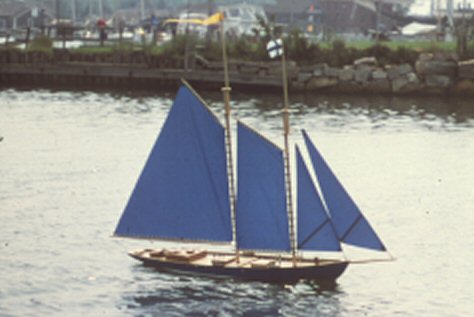reviewed 8/15/2011
Still active
With the popularity of radio-controlled models, the number of people interested in owning a model yacht has also grown - in geometric range. As with model aircraft, the choice of sailing models runs the gamut from child's toy to sophisticated craft.
Stability - the ability of the model not to tip over - is a function of hull design, and most models have ballast keels. Unlike many full-sized racing boats, centerboards are seldom found on racing models. Like full-size keel-boats, model yachts will sink if they fill with water. For this reason a fiberglass hull is a top choice for the beginner unless he has the skill to plank up a watertight hull. To insure that the hull stays dry inside so the model won't sink and, equally important, to keep the radio receiver and equipment dry, the hatch should be designed for easy removal and yet be sealed tight for sailing.

As with any hobby-sport, the cost of the model yacht reflects its degree of sophistication. The market is supplied by a number of highly qualified one-man companies as well as by a handful of larger companies. This mix allows the modeler to choose top quality boats from a nominal $100 up. In general, the cost of model yachting parallels the cost of sport fishing and golf. While some models have a useful life of many years, others become obsolete in a year or two. (More about this later.) A good source of inexpensive models is the used-model marketplace. However, a large number of models of the same class or type being offered used at the same time may be a warning sign that there is something less desirable about that type of model.



A quality model can be an investment lasting for many years. Some modelers have models that have been passed along for a couple of generations. It is worh joining the AMYA, www.amya.org/ "The AMYA is devoted to promoting the designing, building, racing, and preservation of all model sailing yachts. We pursue these goals by recognizing certain Classes of Model Yachts, sanctioning model yacht Regattas, recognizing model Yacht Clubs, publishing a quarterly Model Yachting Magazine, and Promoting model yachting in general. Any operating model sailboat enthusiast will benefit by joining the AMYA and meeting others with the same interests."


Radio system. Two-channel control is the minimum, while models requiring multi-channel (up to seven) may be too difficult for many skippers to cope with. Be sure that the control system includes the sail winch when you price things out. While you can save some cost by purchasing dry battery system, the initial cost of a rechargeable battery is more than paid for if you sail frequently and want the ability to have fresh batteries each time.

Fittings. Examine the fitting requirements of your model. It can be an expensive proposition if the rig is complicated.
Masts. Masts run the gamut from simple wood spars to slotted aluminum through carbon fiber shafts. From a time-of-assembly standpoint, aluminum mast is excellent. For salt-water sailing, however, you will need the anodized aluminum.
Sails. The cost of professionally made sails from such lofts as Carr Sails is a fact of life if you plan to race seriously. Cotton and nylon sailcloth is totally inadequate compared to Dacron and other synthetic sailcloths.

